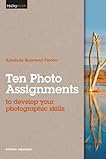 Ten Photo Assignments by Amanda Quintenz-Fiedler
Ten Photo Assignments by Amanda Quintenz-FiedlerMy rating: 3 of 5 stars
Before you attain mastery of a craft, you must first learn the fundamental skills. I know a world class violinist whose teacher spent months having him practice picking up and properly holding his violin. Pianists spending hours on hours starting with scales and octaves. Chefs in their first jobs develop knife skills by cutting food. This book is trying to be the tutor for knife skills for digital photography. It may start out slow, but the goal is to master the tools of the photographer's craft, then you can create what you see in your mind.
For all the sophistication of some modern cameras, there are only a limited number of things that can be adjusted on a camera. Traditionally, it was shutter speed and aperture, and film speed (sensor) to a limited extent. And in digital SLR you also include white balance (instead of using filters). All the fancy features in cameras exist to do this, or help the photographer decide how to make these settings. But for the photographer to make these decisions instead of letting the camera do so, the photographer needs to know the consequences of these decisions. And the way to do that is to experience the difference. And this exercise comprises the majority of the assignments in this book.
The assignments here are very different then most lists of photographic assignments. Usually, when I think of photographic assignments it deals with shooting a specific subject under certain conditions. Here it is the learning of how to use a particular aspect of the camera. So one assignment is a test of how your camera light meter measures exposure, so you can see what your camera considers to be proper exposure, over exposed and underexposed. And when you come across a scene, you can determine what you should set the exposure as (i.e. above or below what the camera reads). The second assignment deals with lenses, so you spend time shooting with each lens you own, so you learn its characteristics at different apertures and have a visceral sense of what each focal length looks like. And so on with the many white balance modes, and different combinations of shutter speed and aperture with equivalent exposures. Not until you get to assignment seven do you start two assignments on composition and two assignments on lighting.
Key to appreciating this book is recognizing it for what it is. The first six assignments of the ten are learning the tools of the photographer's craft. It makes you learn what your instrument can do and how it responds to your changes in controlled conditions, and asks questions so that you can reflect on the outcomes so that you develop an intuition on how the camera works, and you can make decisions when you get to the field. I don't think there is a readily available resource outside of a teacher that would lead you on this path. The last four are more pedestrian and generic. For learning composition and lighting there are many sources of exercises and photo assignments that can teach you more with more scenarios and challenges.
At its base level, photography is a craft and skill. And to learn it well you need to practice it deliberately until the fundamentals are sound and intuitive. This book will take you there. But its title is somewhat deceptive (and maybe there is no title that would work in a book like that) because it is not a standard set of assignments (and I dock a star just for that). Perhaps this book is the Études of digital photography, focusing on getting the technical aspects of photography right. But the artistry is something to be developed elsewhere.
View all my reviews
Note: I received a free electronic copy of this book as part of the O'Reilly Media Blogger program. More information on this book can be found at the 10 Photo Assignments web page
No comments:
Post a Comment